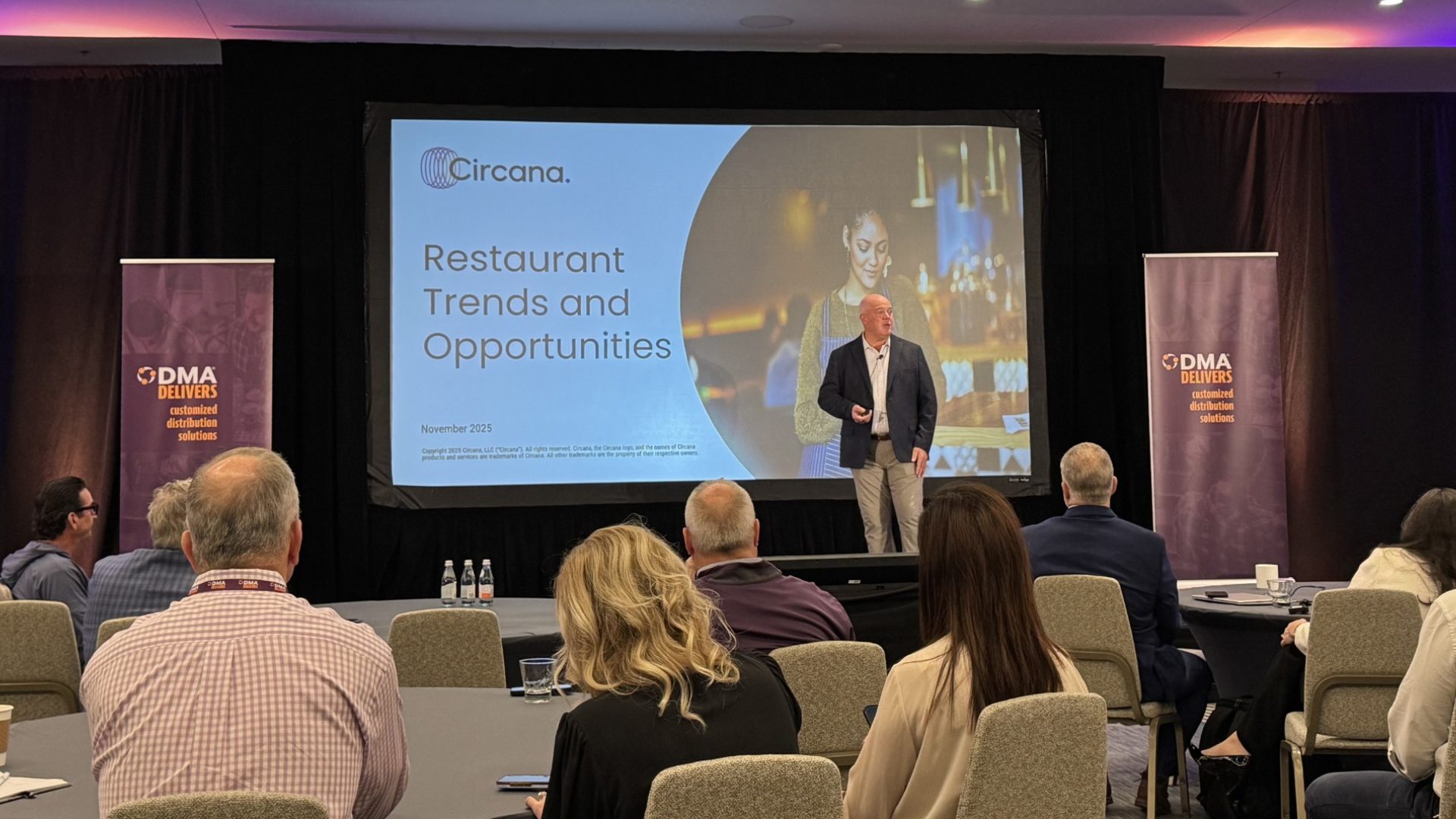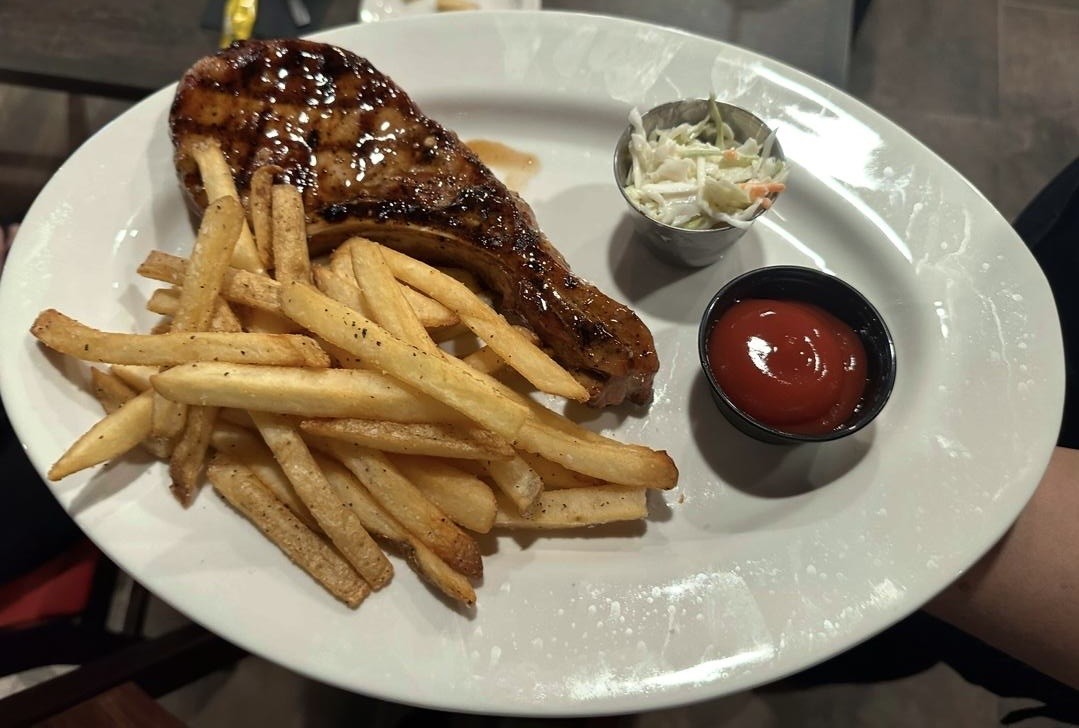SAN ANTONIO – Foodservice distributors, manufacturers, operators, and insights teams gathered at the InterContinental San Antonio Nov. 18-20, for Distribution Market Advantage’s 2025 Fall Conference.
At the event, presentations and panel discussions focused on the best ways to serve the consumer, the prospects for foodservice in 2026, and much more.
‘Flat is the New Up’
Circana’s David Portalatin described a restaurant landscape shaped by economic uncertainty, even as the return-to-office trend provided a modest lift for the industry.
Consumers increasingly value versatility across snacking and beverages, alongside a “return to purity” that’s elevating protein. At the same time, more discretionary spending is flowing to toys and video games, while food—despite being nondiscretionary—has seen reduced wallet share. As such, large chain restaurant transactions fell 2% in 2025 as they contended with financial strain and labor tightness weighed on activity.
Additionally, annual calories per capita declined 2%, as consumers shifted toward protein-rich options and away from sweets, snacks, and alcohol. GLP-1 usage and reduced pantry stocking was further shaping demand. Demographic and economic pressures—slowing population growth and a widening K-shaped economy—are prompting households under $75,000 to cut back sharply on dining out.
Total traffic for the restaurant industry dipped 0.3% in 2025, though fast casual (+3%), fine dining (+2%), and other retail (+2%) grew. For dayparts, breakfast rose 1%, while lunch and p.m. snacks were flat and dinner fell 1%.
Deals now account for 30% of foodservice traffic. Protein-led innovation, especially in chicken, continues to drive consumer interest, while high-protein beverages gain momentum.
Looking to the future, Circana projects 2026 growth of 2.8% in sales, 0.7% in traffic, and a 2.1% check increase.
Serving Raving Fans
Representatives from Pizza Ranch, Cowboy Chicken, Noodles & Company, as well as Taziki’s Mediterranean Café, joined Olo’s Hillary Holmes for a panel discussion on how to best serve raving fans amid rapid expansion.
Cowboy Chicken’s director of marketing, Brittany Mercer, opened by acknowledging the challenge of uniformity across locations, noting that even her husband insists the chicken at one store tastes different. She said this inconsistency was a weakness, but streamlining SKUs, tightening recipes, and prioritizing communication and training helped to make the flavor more uniform across its system.
Taziki’s senior director of supply chain, Jeff Darby, emphasized the importance of strong importer and distributor relationships, given their reliance on products from Greece. “We work with those importers, making sure that we’ve got plenty of stock,” he said, adding that operators are “always trying to prepare for LTOs and spikes in business.”
From an operations perspective, Adam Hing—drawing on prior experience with Darden Restaurant Group, plus his current role as director of supply chain for Noodles & Company—offered insight into forecasting. Surprisingly, he said he relied partly on instinct: “I always came from a guest-first perspective… would you buy this again?” This blend of data and intuition often led to accurate predictions, he said.
Pizza Ranch VP of supply chain and procurement Kelley Crawford offered a detailed look at how supply chain, technology, and guest experience intersect in a real-world operational challenge. Kelly described a major systemwide transition between soda providers—an upgrade that should have been routine after completing “97% of the way through” the rollout. But the final locations proved unexpectedly difficult.
While restoring operations was paramount, just as important was repairing guest trust. “We got some upset guests… we needed to get them coupons issued, or what do we do to get them back in?” she said, noting how it was important to make sure consumers were aware of their steps to own the issue.
Delivering Impact Through Distribution
Adrienne Moncrief, Cleveland Research Company executive director of foodservice and convenience, briefly shared her viewpoint on the industry before hosting a distributor panel that featured representatives of Gordon Food Service, Shamrock Foods, Ben E. Keith Co., and Harbor Foodservice.
“As we look ahead, many of the same forces shaping 2025 will continue—value pressure, shifting consumer behavior, and the need for constant innovation,” she said. “The brands that win will be the ones that keep evolving their menus, their marketing, and their guest experience to stay relevant in a tougher, more competitive landscape=.”
The panel discussion focused on the “pathway to yes” and finding ways to exceed customer expectations.
Cannon Whitby, senior vice president of Shamrock Foods, shared how the company was able to help a company contending with a sudden distributor transition.
“A true partner isn’t just there when things are easy — it’s there when you need them. When a customer’s distributor transition on the East Coast fell apart, we pulled together 16 drivers and seven transportation supervisors, flew them across the country, and kept their groceries moving for 45 days. That’s what partnership means to us,” he said.
Harbor Foods chairman and CEO Justin Erickson shared how his company developed a system to linen solution to help a multi-unit Mexican concept pick up and return laundry via existing food distribution routes. This led to them taking on the chain’s mail and materials distribution.
Chris Lewis, who serves as SVP of corporate sales for Ben E. Keith Company, shared how his company supported a fast-growing chain struggling with proprietary items during expansion. By analyzing inbound efficiencies and collaborating with the culinary team, they replaced difficult items with vendor-aligned alternatives, and the resulting cost savings became a key data point in the chain’s refinancing negotiations.
When asked to define the perfect partner, Karen Gordon-Warren, president of U.S. broadline distribution for Gordon Food Service, said: “We’re really looking for folks who want to partner with us in a way that positions the foodservice distributor as an extension of their team. When that’s the mindset, you get great collaboration, honest conversations, and a lot more clarity around what you’re trying to accomplish.”
Winning Together in Tough Regulatory Times
In a panel focused on regulatory issues moderated by Foodini founder and CEO Dylan McDonnell, participants focused on new state laws regarding ingredients in California, Louisiana, West Virginia, and Texas that would become effective in the next few years, causing labeling headaches for many food producers who operated at the national scale.
“The new normal is this patchwork of state laws. You have California upfront regulating, then West Virginia, then Texas and Louisiana—all different, all overlapping. It’s a quagmire, and operators are having to reformulate, reroute, and relabel just to keep up,” said Emily Cowley Leongini, FDA regulatory attorney at ArentFox Schiff.
Additionally, Oregon, Colorado, and California had either already launched or were developing extended producer responsibility (EPR) for packaging. In general, ERP would make producers and distributors financially responsible for packaging waste and recycling.
“Extended Producer Responsibility is so complex that, especially in distribution, it’s a huge struggle to wrap your arms around. Every state has its own nuances, and if we’re not careful, we risk double-reporting or misreporting entirely,” noted Sven Fickeler, senior corporate counsel at Bunzl.
The panel also focused on new rules in California on sustainability and carbon, and SB 68, which would require allergen labeling on physical menus, digital menus, and QR codes for chains with more than 20 locations.
“What California is doing now is just the beginning. As sustainability and carbon accountability keep moving up the supply chain, every producer, distributor, and operator will need to plan for a world where climate reporting and packaging transparency are part of day-to-day business,” said Jared Keefer, senior director of operational excellence at Shamrock Foods.
The best way to handle an influx of regulatory changes was to leverage AI, using purpose-built “agents” to scrape regulatory sites. They also recommended building cross-functional regulatory surveillance teams, leveraging external counsel for outside perspective, and centralizing product and packing data.
When asked about the ideal partnership between operators and distributors, Kara Gordon-Warren, president of U.S. broadline distribution with Gordon Food Service, said this:
“We’re really looking for folks who want to partner with us in a way that positions the foodservice distributor as an extension of their team. When that’s the mindset, you get great collaboration, honest conversations, and a lot more clarity around what you’re trying to accomplish.”
Creating Superfans Among Customers and Stakeholders
Brittany Hodak, author of Creating Superfans, opened her keynote presentation with an anecdote about a treadmill delivery. She said the delivery person hated the product, and shared his thoughts with her.
This interaction colored her opinion of the product, but also represented an important rule of business: one employee’s interaction with a customer can drastically alter the perception of a company.
“Experience is everything, and everything is experience,” she noted.
She cited research saying 80% of consumers say experience is as important as product or service when it comes to companies, so she argued every employee can be an “acting chief of experience” within the experience department.
She also shared a definition of a superfan: “a customer or stakeholder who is so delighted by their experience with a brand, product, or service that they become an enthusiastic advocate.”
She noted stakeholders who are superfans can engender trust and loyalty from consumers by making things personal. And this was important to defeat apathy via advocacy – eliminating a major pain point for consumers.
DMA Rebrands but Keeps Focus on Strategic Goals
DMA president and CEO Angela Korompilas unveiled new branding for the company at the event, including a new website and new colors. Korompilas noted the rebrand represented a new era for the company, but stressed that DMA would remain focused on the same four pillars established in its strategic plan:
- Provide compelling value proposition for customers
- Strengthen member integration and value
- Maintain an optimal distributor network
- Create a high performance culture
Looking to 2026, DMA plans to standardize reporting, evaluate and improve price audit capabilities, expand strategic account planning, enhance order-entry platforms, and pursue cost-to-serve optimization.
Member engagement will be reinforced through more consistent business reviews, clearer goal-setting, data-driven insights, and collaborative materials that streamline the customer experience.
DMA will further leverage modeling tools, freight optimization, and capacity planning to sustain an effective distribution network.
Internally, the organization has realigned teams, improved workflows through CRM automation, standardized processes, and expanded training resources. Moving forward, DMA will continue focusing on technology, data, AI enablement, and talent development to deliver meaningful impact and strengthen partnerships across the network.
DMA Unveils 2025 Awards
DMA unveiled its awards for 2025, starting with its Championing Excellence Award, which recognized excellence in distribution. The company recognized three companies for the Championing Excellence Award, based on the number of brands they serve:
- Ben E. Keith Foods
- Harbor Foodservice
- Upper Lake Foods
Ben E. Keith was given the newly created Create Raving Fans Award. Additionally, the company awarded Jo Hart of Shamrock Foods with its Impact Award.










